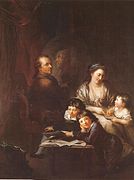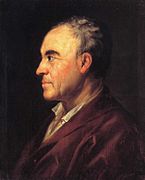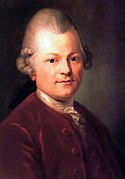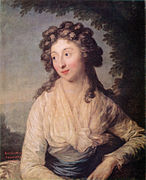Anton Graff
Anton Graff | |
|---|---|
Academy of Fine Arts, Vienna and the Academy of Fine Arts, Munich | |
| Patron(s) | Royal Courts of Prussia and Saxony |
Anton Graff (18 November 1736 – 22 June 1813) was an eminent Swiss portrait artist. Among his famous subjects were Friedrich Schiller, Christoph Willibald Gluck, Heinrich von Kleist, Frederick the Great, Friederike Sophie Seyler, Johann Gottfried Herder, Gotthold Ephraim Lessing, Moses Mendelssohn and Christian Felix Weiße. His pupils included Emma Körner, Philipp Otto Runge and Karl Ludwig Kaaz.
Life and work
This section may be too long to read and navigate comfortably. (May 2022) |

Anton Graff was born as the seventh child of the craftsman Ulrich Graff and Barbara Graff née Koller at Untertorgasse 8 in
Graff made portraits of nearly 1,000 of his contemporaries and was the leading portrait painter in Germany in the late 18th and early 19th century. Graff was also the main portrait painter of German poets between the
Graff was also very popular with the
He also knew how to paint dresses and draperies of different materials and colours in a natural way. His role model in this field was the French court painter Hyacinthe Rigaud.[7] In 1765/66 Graff portrayed Elisabeth Sulzer in a blue silk dress with silver laces and fur collar and borders.[8]
In his early years, Graff did hardly ever paint any background details in his portraits. He usually kept the background monochrome. However, in his later years he also paid more attention to the background. Usually he painted the sitter in outdoor surroundings, as was the fashion at that time in England. The price for a portrait by Graff was calculated by size and details of the sitter's clothes. That it was not always easy for Graff to portrait the famous of the time shows the remark he made while painting Friedrich Schiller: "He cannot sit still."[9] Graff was much in demand. He could live a comfortable life with his income.[9]
In 1769 Graff met Philipp Erasmus Reich, a well known bookseller and publisher in Leipzig. Reich became a good friend of Graff. He engaged him to portrait his scholar friends. In September 1771, Graff travelled to Berlin and portrayed Gotthold Ephraim Lessing in Johann Georg Sulzer's apartment. Lessing's comment on his portrait was: "Do I really look that terribly nice?"[10] In Berlin Graff also portrayed Moses Mendelssohn and Johann Georg Sulzer, his future father-in-law.
In his later years Graff turned to painting
Graff was a sociable person. He cultivated friendships with many of his sitters, business partners and colleagues such as the Polish
Graff travelled quite often to
On 16 October 1771, Anton Graff married Elisabetha Sophie Augusta Sulzer, called "Guste".. His tomb does not exist anymore.
Graff was a prolific artist. He painted some 2,000 paintings and drawings. His paintings, especially the portraits, are much sought-after. Many of them are in museums and private collections in
In honour of their famous citizen the Berufsbildungsschule Winterthur (BBW) (School for Vocational Training) named their building after Graff. The "Anton-Graff-Haus".[15]
In Winterthur and Dresden there are streets named after Anton Graff.
2013 jubilee exhibitions take place in the Museum Oskar Reinhart, Winterthur, and in the Old National Gallery in Berlin.
Gallery
-
Friedrich Schiller. Anton Graff started the portrait in 1786. However, since Schiller could "not sit still" he only finished it in 1791. The painting was often copied. The original portrait can be seen at the "Kügelgenhaus – Museum der Dresdner Romantik" in Dresden.
-
Moses Mendelssohn (1771).
-
Self-portrait, Anton Graff and his family (1785). This painting is in the Museum Oskar Reinhart in Winterthur.
-
Elisa von der Recke (1797).
-
Johann Georg Sulzer (1774). Anton Graff's father-in-law.
-
Gotthold Ephraim Lessing (1771).
-
George Leopold Gogel (1796). This painting is at the Hermitage Museum in Saint Petersburg.
-
Friederike Sophie Seyler (formerly Hensel)
-
Portrait KonstancjaLviv National Art Gallery
References
Notes
- ^ a b c d e f Berckenhagen, p. 34
- ^ Berckenhagen, p. 12
- ^ Berckenhagen, p. 36
- ^ Portrait of Stanislaw Kostka Potocki. Archived 29 July 2014 at the Wayback Machine. Wilanów Palace Museum.
- ^ Berckenhagen, p. 119
- ^ Berckenhagen, p. 19
- ^ Berckenhagen, p. 13
- ^ Berckenhagen, p. 348
- ^ a b Berckenhagen, p. 32
- ^ Berckenhagen, p. 18
- ^ Berckenhagen, p. 7
- ^ Berckenhagen, p. 35
- ^ a b Berckenhagen, p. 38
- ^ "Art Museum of Estonia". Retrieved 15 February 2013.
- ^ Anton-Graff-Haus, Zürcherstrasse 28, Winterthur
Bibliography and catalogue
- Berckenhagen, Ekhart: Anton Graff – Leben und Werk. Deutscher Verlag für Kunstwissenschaft, Berlin, 1967 (catalogue raisonné)
- Marc Fehlmann und Birgit Verwiebe (Ed.): Anton Graff: Gesichter einer Epoche. (Exhibition catalogue: Museum Oskar Reinhart, Winterthur; Nationalgalerie – Staatliche Museen zu Berlin.) München: Hirmer, 2013.
Further reading
- Johann Caspar Füssli: Joh. Caspar Füesslins Geschichte der besten Künstler in der Schweitz. Nebst ihren Bildnissen. Orell, Gessner, Füessli. Zürich, 1769–1779 (5 Bde)
- Otto Waser: Anton Graff 1736–1813. Huber, Frauenfeld u. Leipzig, 1926
- Ernest Giddey, Fribourg (Ed.): Préromantisme en Suisse? Editions Universitaires, 1982 (Colloques de la Société Suisse des Sciences Humaines)
- Martin Bircher u. Gisold Lammel, Zürich (Hrsg.): Helvetien in Deutschland. Schweizer Kunst aus Residenzen deutscher Klassik 1770–1830. Zürich, Städtische Galerie zum Strauhof, 1990–91; Schwäbisch Hall, Hällisch-Fränkisches Museum, 1991
- Roland Kanz: Dichter und Denker im Porträt. Spurengänge zur deutschen Porträtkultur des 18. Jahrhunderts. Deutscher Kunstverlag, München, 1993
- Jane Turner (Editor): The Dictionary of Art (34 volumes). Macmillan (London); Grove (New York), 1996
External links
- . New International Encyclopedia. 1905.
- Works by or about Anton Graff at Internet Archive











